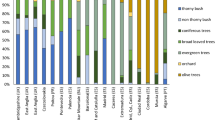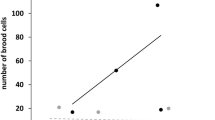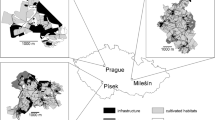Abstract
Agricultural landscapes play an important role in biodiversity conservation. The Tree Pipit (Anthus trivialis) was once a widespread breeding bird in European farmlands. Today, however, its numbers are sharply declining in most European countries. The aim of our study was to compare territory densities of Tree Pipits in common pastures and control plots in the surrounding pre-alpine agricultural landscape in southern Bavaria (Germany). Additionally, we determined the drivers of territory and home-range establishment in Tree Pipits. Habitat composition in common pastures and control plots reflected distinct differences in land-use intensity. Common pastures had larger areas of nutrient-poor habitats and higher landscape diversity compared to control plots. In line with this, we detected a clear response of Tree Pipits to differences in habitat composition. Territories were nearly exclusively found in common pastures. Within the common pastures, Tree Pipits preferred those parts that had higher landscape diversity and, additionally, at the territory scale, larger areas of groups of trees. The common pastures are important refuges for the threatened Tree Pipit in the pre-alpine agricultural landscape of the study area. In contrast to the control plots, the common pastures provided (i) sufficient suitable song posts and (ii) heterogeneous vegetation with appropriate nesting sites and a high availability of arthropod food resources. Our study corroborates findings from other studies across Europe highlighting the prime importance of traditionally used wood pastures for the Tree Pipit, and for biodiversity in general.
Zusammenfassung
Allmendweiden sind wichtige Refugien für eine gefährdete Singvogelart in der prä-alpinen Agrarlandschaff.
Agrarlandschaften spielen eine wichtige Rolle für den Schutz der Biodiversität. Der Baumpieper (Anthus trivialis) war früher ein häufiger Brutvogel in europäischen Agrarlandschaften. Das Ziel unserer Studie war der Vergleich der Revierdichte des Baumpiepers in Allmendweiden und in Kontrollflächen der umgebenden prä-alpinen Agrarlandschaft in Südbayern (Deutschland). Zudem haben wir die Umweltfaktoren ermittelt, die für die Reviergründung und die Nutzung des Aktionsraums entscheidend waren. Die Habitattypenzusammensetzung in den Allmendweiden und Kontrollflächen spiegelt deutliche Unterschiede in der Landnutzungsintensität wider. Allmendweiden wiesen größere Flächen an nährstoffarmen Habitaten und eine höhere Landschaftsdiversität als die Kontrollflächen auf. Baumpieper zeigten eine deutliche Reaktion auf diese Unterschiede in der Habitattypenzusammensetzung. Reviere wurden nahezu ausschließlich in den Allmendweiden festgestellt. Innerhalb der Allmendweiden wurden die Teile präferiert, die eine hohe Landschaftsdiversität aufwiesen und auf der Revierebene zusätzlich durch eine größere Fläche an Baumgruppen gekennzeichnet waren. Allmendweiden sind wichtige Refugien für den gefährdeten Baumpieper in der prä-alpinen Agrarlandschaft des Untersuchungsgebiets. Im Gegensatz zu den Kontrollflächen wiesen Allmendweiden erstens ausreichend geeignete Singwarten und zweitens eine heterogene Vegetation mit Nistplätzen und einer hohen Verfügbarkeit an Arthropoden als Nahrung auf. Unsere Studie bestätigt die Befunde anderer Arbeiten aus Europa, die traditionell genutzten Waldweiden eine herausragende Bedeutung für den Baumpieper und für den Erhalt der Biodiversität generell zusprechen.



Similar content being viewed by others
References
Baillie SR, Marchant JH, Leech DI, Massimino D, Sullivan MJP, Eglington SM, Barimore C, Dadam D, Downie IS, Harris SJ, Kew AJ, Newson SE, Noble DG, Risely K, Robinson RA (2014) BirdTrends 2014: Trends in numbers, breeding success and survival for UK breeding birds. BTO Research Report. BTO, Thetford. http://www.bto.org/birdtrends. Accessed 13 June 2017
Barnosky AD, Matzke N, Tomiya S, Wogan GOU, Swartz B, Quental TB, Marshall C, McGuire JL, Lindsey EL, Maguire KC, Mersey B, Ferrer EA (2011) Has the Earth′s sixth mass extinction already arrived? Nature 471:51–57. https://doi.org/10.1038/nature09678
Bartón M (2016) Package MuMIn. Available from https://www.r-project.org. Accessed 03 September 2017
Bauer HG, Bezzel E, Fiedler W (2012) Das Kompendium der Vögel Mitteleuropas. Alles über Biologie, Gefährdung und Schutz: Passeriformes—Sperlingsvögel, 2nd edn. AULA-Verlag, Wiebelsheim
Benton TG, Bryant DM, Cole L, Crick HQR (2002) Linking agricultural practice to insect and bird populations: a historical study over three decades. J Appl Ecol 39:673–687. https://doi.org/10.1046/j.1365-2664.2002.00745.x
Berg Å (2008) Habitat selection and reproductive success of ortolan buntings Emberiza hortulana on farmland in central Sweden—The importance of habitat heterogeneity. Ibis 150:565–573
BfN (Bundesamt für Naturschutz) (2017) Landschaftssteckbriefe. https://www.bfn.de. Accessed 05 October 2017
Bibby CJ, Burgess ND, Hill DA, Mustoe SH (2000) Bird census techniques, 2nd edn. Academic Press, London
BirdLife International (2004) Birds in Europe: population estimates, trends and conservation status. BirdLife Conservation Series, 12th edn. BirdLife International, Cambridge
BMU (Bundesministerium für Umwelt, Naturschutz und Reaktorsicherheit) (2007) Nationale Strategie zur biologischen Vielfalt. BMU, Berlin
Burnham KP, Anderson DR (2002) Model selection and multimodel inference. A practical information-theoretic approach, Springer
Burton NHK (2007) Influences of restock age and habitat patchiness on Tree Pipits Anthus trivialis breeding in Breckland pine plantations. Ibis 149:193–204. https://doi.org/10.1111/j.1474-919X.2007.00737.x
De Vos JM, Joppa LN, Gittleman JL, Stephens PR, Pimm SL (2014) Estimating the normal background rate of species extinction. Conserv Biol 29(2):452–462. https://doi.org/10.1111/cobi.12380
Denerley, C. (2009) Foraging habitat use and aspects of the breeding ecology of Yellowhammers and Tree Pipits in Thetford Forest. MSc thesis, University of East Anglia
Diaz M, Campos P, Pulido FJ (1997) The Spanish dehesas: a diversity in land-use and wildlife. In: Pain D, Pienkowski M (eds) Farming and birds in Europe: the common agricultural policy and its implications for bird conservation. Academic Press, London, pp 178–209
Donald PF, Green RE, Heath MF (2001) Agricultural intensification and the collapse of Europe’s farmland bird populations. Proc Royal Soc London B Biol Sci 268:25–29. https://doi.org/10.1098/rspb.2000.1325
Donald PF, Sanderson FJ, Burfield IJ, van Bommel FPJ (2006) Further evidence of continent-wide impacts of agricultural intensification on European farmland birds, 1990–2000. Agric Ecosyst Environ 116:189–196. https://doi.org/10.1016/j.agee.2006.02.007
Dormann CF, Elith J, Bacher S, Buchmann C, Carl G, Carré G, García Marquéz JR, Gruber B, Lafourcade B, Leitão PJ, Münkemüller T, McClean C, Osborne PE, Reineking B, Schröder B, Skidmore AK, Zurell D, Lautenbach S (2013) Collinearity: a review of methods to deal with it and a simulation study evaluating their performance. Ecography 36:27–46. https://doi.org/10.1111/j.1600-0587.2012.07348.x
Eurostat (2016) Europe in figures—Eurostat yearbook 2016. Statistical office of the European Union, Luxembourg. http://ec.europa.eu. Accessed 23 August 2017
Fischer S, Flade M, Schwarz J (2005) Revierkartierung. In: Südbeck P, Andretzke H, Fischer S, Gedeon K, Schikore T, Schröder K, Sudfeldt C (eds) Methodenstandards zur Erfassung der Brutvögel Deutschlands. Dachverband Deutscher Avifaunisten, Radolfzell, pp 47–58
Flohre A, Fischer C, Aavik T, Bengtsson J, Berendse F, Bommarco R, Ceryngier P, Clement LW, Dennis C, Eggers S, Emmerson M, Geiger F, Guerrero I, Hawro V, Inchausti P, Liira J, Morales MB, Oñate JJ, Pärt T, Weisser WW, Winqvist C, Thies C, Tscharntke T (2011) Agricultural intensification and biodiversity partitioning in European landscapes comparing plants, carabids, and birds. Ecol Appl 21(5):1772–1781. https://doi.org/10.1890/10-0645.1
Foley JA, DeFries R, Asner GP, Barford C, Bonan G, Carpenter SR, Chapin FS, Coe MT, Daily GC, Gibbs HK, Helkovski JH, Holloway T, Howard EA, Kucharik CJ, Monfreda C, Patzz JA, Prentice IC, Ramankutty N, Snyder PK (2005) Global consequences of land use. Science 309:570–574. https://doi.org/10.1126/science.1111772
Fünfstück H-J, von Lossow G, Schöpf H (2004) Rote Liste gefährdeter Brutvögel (Aves) Bayerns. Schriften-R Bayer Landesamt f Umweltschutz 166:19–24
Gatter W (2000) Vogelzug und Vogelbestände in Mitteleuropa. AULA-Verlag, Wiebelsheim
Graham CT, Wilson MW, Gittings T, Kelly TC, Irwin S, Quinn JL, O’Halloran J (2017) Implications of afforestation for bird communities: the importance of preceding land-use type. Biodiv Conserv 26(1):3051–3071. https://doi.org/10.1007/s10531-015-0987-4
Gregory RD, Noble DG, Custance J (2004) The state of play of farmland birds: population trends and conservation status of lowland farmland birds in the United Kingdom. Ibis 146:1–13
Gregory RD, Vorisek P, van Strien A, Gmelig Meyling AW, Jiguet F, Fornasari L, Reif J, Chylarecki P, Burfield IJ (2007) Population trends of widespread woodland birds in Europe. Ibis 149(2):78–97. https://doi.org/10.1111/j.1474-919X.2007.00698.x
Grueber CE, Nakagawa S, Laws RJ, Jamieson IG (2011) Multimodel inference in ecology and evolution: challenges and solutions. J Evol Biol 24:699–711. https://doi.org/10.1111/j.1420-9101.2010.02210.x
Grüneberg C, Bauer HG, Haupt H, Hüppop O, Ryslavy T, Südbeck P (2015) The Red List of breeding birds of Germany, 5th edn. In: Deutscher Rat für Vogelschutz (ed) Berichte zum Vogelschutz, 52th edn. Landesbund für Vogelschutz (LBV), Hilpolstein, pp 19–67
Hagemeijer WJM, Blair MJ (eds) (1997) The EBCC atlas of European breeding birds: their distribution and abundance. Poyser, London
Hartel T, Plieninger T (2014) European wood-pastures in transition—a social-ecological approach. Routledge, London and New York
Helbing F, Blaeser TP, Löffler F, Fartmann T (2014) Response of Orthoptera communities to succession in alluvial pine woodlands. J Insect Conserv 18:215–224. https://doi.org/10.1007/s10841-014-9632-x
Henle K, Alard D, Clitherow J, Corb P, Firbank L, Kull T, McCracken D, Moritz RFA, Niemelä J, Rebane M, Wascher D, Watt A, Young J (2008) Identifying and managing the conflicts between agriculture and biodiversity conservation in Europe: a review. Agric Ecosyst Environ 124:60–71. https://doi.org/10.1016/j.agee.2007.09.005
Kleijn D, Kohler F, Baldi A, Batary P, Concepcion E, Clough Y, Diaz M, Gabriel D, Holzschuh A, Knop E, Kovacs A, Marshall E, Tscharntke T, Verhulst J (2009) On the relationship between farmland biodiversity and land-use intensity in Europe. Proc R Soc Lond B Biol Sci 276:903–909. https://doi.org/10.1098/rspb.2008.1509
Konold W (1996) Von der Dynamik einer Kulturlandschaft. Das Allgäu als Beispiel. In: Konold W (ed) Naturlandschaft—Kulturlandschaft. Die Veränderung der Landschaften nach der Nutzbarmachung durch den Menschen. Ecomed, Landsberg, pp 121–136
Kumstátová T, Brinke T, Tomková S, Fuchs R, Petrusek A (2004) Habitat preferences of Tree Pipit (Anthus trivialis) and Meadow Pipit (A. pratensis) at sympatric and allopatric localities. J Ornithol 145:334–342. https://doi.org/10.1007/s10336-004-0048-3
Lederbogen D, Rosenthal G, Scholle D, Trautner J, Zimmermann B, Kaule G (2004) Allmendweiden in Südbayern: naturschutz durch landwirtschaftliche Nutzung. Angewandte Landschaftsökologie 62:1–469
Löffler F, Fartmann T (2017) Effects of landscape and habitat quality on Orthoptera assemblages in pre-alpine calcareous grasslands. Agric Ecosyst Environ 248:71–81. https://doi.org/10.1016/j.agee.2017.07.029
Loske KH (1985) Anthus trivialis (Linnaeus 1758). In: von Glutz Blotzheim UN (ed) Handbuch der Vögel Mitteleuropas. Vol. 10. Passeriformes.—(Part 1) 2. Motacillidae—Prunellidae. AULA-Verlag, Wiebelsheim, pp 576–610
Loske KH (1987a) Habitatwahl des Baumpiepers (Anthus trivialis). J Ornithol 128(1):33–47. https://doi.org/10.1007/BF01644789
Loske KH (1987b) On the ethology of the Tree Pipit (Anthus trivialis). Ecol Birds 9(1):1–30
Matzdorf B, Reutter M, Hübner C (2010) Gutachten-Vorstudie—Bewertung der Ökosystemdienstleistungen von HNV-Grünland (High Nature Value Grassland). Unpublished report
Meury R (1989) Siedlungsdichte und Raumnutzung des Baumpiepers Anthus trivialis im inselartig verteilten Habitat des aargauischen Reusstals. Ornith Beob 86:105–113
Moga C, Hartel T, Öllerer K (2009) Ancient oak wood-pasture as a habitat for the endangered Tree Pipit Anthus trivialis. Biologia 64(5):1–5. https://doi.org/10.2478/s11756-009-0167-7
Newton I (2004) The recent declines of farmland bird populations in Britain: an appraisal of causal factors and conservation actions. Ibis 146:579–600. https://doi.org/10.1111/j.1474-919X.2004.00375.x
Newton I (2017) Farming and birds. William Collins, London
O’Neill RV, Krummel JR, Gardner RH, Sugihara G, Jackson B, DeAngelis DL, Milne BT, Turner MG, Zygmunt B, Christensen SW, Dale VH, Graham RL (1988) Indices of landscape pattern. Landsc Ecol 1(3):153–162. https://doi.org/10.1007/BF00162741
Pätzold R (1990) Der Baumpieper, 1st edn. Ziemsen Verlag, Wittenberg
Pavel V (2004) The impact of grazing animals on nesting success of grassland passerines in farmland and natural habitats: a field experiment. Folia Zool 53(2):171–178
Petrusková T, Osiejuk TS, Linhart P, Petrusek A (2008) Structure and complexity of perched and flight songs of the Tree Pipit (Anthus trivialis). Ann Zool Fenn 45(2):135–148. https://doi.org/10.5735/086.045.0205
Pille A, Scholle D, Hofmann C (2002) Institutionelle Voraussetzungen der Allmendweide. In: der Berichte ANL (ed) Bayerische Akademie für Naturschutz und Landschaftspflege (ANL), 26th edn. Bayerische Akademie für Naturschutz und Landschaftspflege (ANL), Laufen, pp 30–36
Pinto-Correia T, Mascarenhas J (1999) Contribution to the extensification/intensification debate: new trends in the Portuguese montado. Landsc Urban Plan 46:125–131. https://doi.org/10.1016/S0169-2046(99)00036-5
Riecken U, Finck P, Raths U, Schröder E, Ssymank A (2006) Rote Liste der gefährdeten Biotoptypen in Deutschland, 2nd edn. Naturschutz und Biologische Vielfalt, vol 34, Bundesamt für Naturschutz, Bonn, pp 1–318. https://doi.org/10.1002/9783527678471.hbnl2003006
Ringler A, Grabherr G (2017) Entwicklungstendenzen des Grünlandes in den Alpen. Nat Landsch 9(10):424–431
Rockström J, Steffen W, Noone K, Persson A, Chapin FS, Lambin EF, Lenton TM, Scheffer M, Folke C, Schellnhuber HJ, Nykvist B, de Wit CA, Hughes T, van der Leeuw S, Rodhe H, Sorlin S, Snyder PK, Costanza R, Svedin U, Falkenmark M, Karlberg L, Corell RW, Fabry VJ, Hansen J, Walker B, Liverman D, Richardson K, Crutzen P, Foley JA (2009) A safe operating space for humanity. Nature 461(7263):472–475. https://doi.org/10.1038/461472a
Sala OE, Chapin FS, Armesto JJ, Berlow E, Bloomfield J, Dirzo R, Huber-Sanwald E, Huenneke LF, Jackson RB, Kinzig A, Leemans R, Lodge DM, Mooney HA, Oesterheld M, Poff NL, Sykes MT, Walker BH, Walker M, Wall DH (2000) Global biodiversity scenarios for the year 2100. Science 287:1770–1774. https://doi.org/10.1126/science.287.5459.1770
Sanderson FJ, Donald PF, Pain DJ, Burfield IJ, van Bommel FPJ (2006) Long-term population declines in Afro-Palearctic migrant birds. Biol Conserv 131:93–105. https://doi.org/10.1016/j.biocon.2006.02.008
Streitberger M, Hermann G, Kraus W, Fartmann T (2012) Modern forest management and the decline of the Woodland Brown (Lopinga achine) in Central Europe. For Ecol Manag 269:239–248. https://doi.org/10.1016/j.foreco.2011.12.028
Succow M, Jeschke L (1990) Moore in der Landschaft. Urania-Verlag, Leipzig
R Development Core Team (2017) R: a language and environment for statistical computing. http://www.r-project.org. Accessed 04 July 2017
van Klink R, van der Plas F, van Noordwijk CGE, WallisDeVries MF, Olff H (2015) Effects of large herbivores on grassland arthropod diversity. Biol Rev 90:347–366. https://doi.org/10.1111/brv.12113
Vickery PD, Tallowin JR, Feber RE, Asteraki EJ, Atkinson PW, Fuller RJ, Brown VK (2001) The management of lowland neutral grasslands in Britain: effects of agricultural practices on birds and their food resources. J Appl Ecol 38:647–664. https://doi.org/10.1046/j.1365-2664.2001.00626.x
Wilson JD, Evans AD, Grice PV (2009) Bird conservation and agriculture. Cambridge University Press, Cambridge. https://doi.org/10.1086/652355
Acknowledgements
We are grateful to Wolfgang Kraus (Landratsamt Garmisch-Partenkirchen), Sabine Kraus and Annette Saitner (Landratsamt Bad Tölz-Wolfratshausen), Dieter Frisch (Landratsamt Ostallgäu) and Johannes Wölfl (Landratsamt Weilheim-Schongau) for providing contact data for the members of the grazing associations. Additionally, we would like to thank the members of the grazing associations for allowing access to their commons. Tereza Petrusková, Jörg Rietze, Florian Straub and an anonymous reviewer made valuable comments on an earlier version of the manuscript.
Author information
Authors and Affiliations
Corresponding author
Additional information
Communicated by T. Gottschalk.
Appendix
Appendix
See Table 4.
Rights and permissions
About this article
Cite this article
Schwarz, C., Trautner, J. & Fartmann, T. Common pastures are important refuges for a declining passerine bird in a pre-alpine agricultural landscape. J Ornithol 159, 945–954 (2018). https://doi.org/10.1007/s10336-018-1561-0
Received:
Revised:
Accepted:
Published:
Issue Date:
DOI: https://doi.org/10.1007/s10336-018-1561-0




